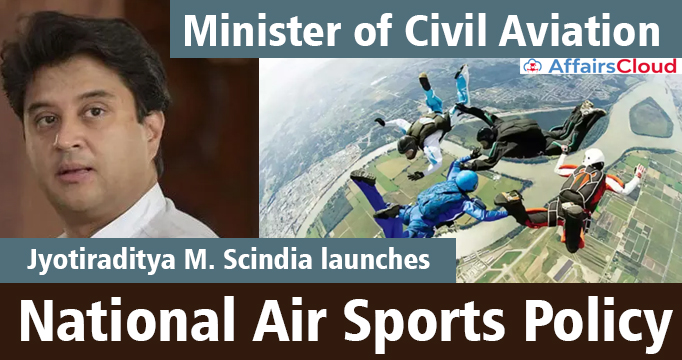
The National Air Sports Policy 2022 (NASP 2022) was launched by Union Minister Jyotiraditya M. Scindia, Ministry of Civil Aviation (MoCA), with the aim of optimizing India’s potential in the field of air sports.This is India’s First National Airsports Policy.
By 2030, the NASP 2022 aims to make India one of the top sports nations in the world by providing a safe, affordable, accessible, enjoyable, and sustainable air sports ecosystem.
- Target-The policy has the potential to be an income generator worth Rs. 8,000–10,000 crores.
- In this industry, India now produces revenues of around Rs 80 crore to Rs 100 crore.
Dignitaries Present
The event was attended by Rajiv Bansal, Secretary, Ministry of Civil Aviation (MoCA); Sanjeev Kumar, Chairman, Airport Authority of India (AAI); Amber Dubey, Joint Secretary, MoCA; Rubina Ali, Joint Secretary, MoCA; SK Mishra, Joint Secretary, MoCA; Piyush Srivastava, Senior Economic Advisor, MoCA, and PK Thakur, Deputy Director General, MoCA.
During the event, the Union Minister met with Shital Mahajan and Rachel Thomas, two Indian Air Sports players who are both sky drivers and Padma-Shri awardees.
- Shital Mahajan – the first woman to jump over Antarctica from 10,000 feet in an accelerated free fall, the youngest woman to jump over both the North and South Poles, and the first woman to do so without trials.
- Rachel Thomas – the first Indian woman to do a 7,000-foot skydive over the North Pole.
Potential of India in the Field of Air Sports
i.Air sports refer to a variety of sports that involve the use of air as a medium. It includes activities such as air racing, aerobatics, aero modelling, hang gliding, paragliding, paramotoring, and skydiving, etc.,
ii.With its vast geographical area, diverse topography, and favourable weather, India has the potential to become one of the world’s major air sports nations.
- It has a thriving culture for adventure sports and aviation as the world’s second most populated country and one of the youngest populations.
Significance of Having an Aerospace Policy
i.In India, the multiplier benefits in terms of growth in travel, tourism, infrastructure, and local employment, especially in hilly areas of the country, are several times more than the direct revenue from air sports activities.
ii.By establishing air sports hubs across the country,they will attract international air sports professionals and tourists.
Note:
- The Fédération Aéronautique Internationale (FAI) is the world governing body for air sports, with headquarters in Lausanne, Switzerland.
- It was established on October 14, 1905, and it sets standards, organises events, and keeps track of world records. FAI has more than 100 members.
National Air Sports Policy 2022 (NASP 2022)
The NASP 2022 is a first step toward realising India’s potential in the field of aviation.
- It is drafted with inputs from policymakers, practitioners, and the general public in mind, and it ensures the establishment of high-quality infrastructure, equipment, instructors, and services.
The NASP 2022 will automatically supersede any existing air sports policies and regulations, with effect from the date of approval of the policy.
Key Objectives of NASP 2022
i.To foster a culture of air sports in India
ii.Provide for the adoption of international best practices in safety in areas such as air sports infrastructure, equipment, operations, maintenance, and training.
iii. Create a governance structure that is simple, user-friendly, and effective.
iv.Increase the participation and achievement of Indian athletes in international air sport events; and
v.Promote the design, development, and manufacturing of air sports equipment in India in compliance with the Atmanirbhar Bharat Abhiyan.
Policy Coverage: The policy will cover the following air sports in India: –
The National Air Sport Policy (NASP), 2022, lists 11 games under this category.
Aerobatics, Aero modeling and model rocketry, Amateur-built and experimental aircraft, Ballooning, Drones, Gliding and powered gliding, Hang gliding and powered hang gliding, Parachuting (including skydiving, BASE jumping and wing suits etc.), Paragliding and para motoring (including powered parachute trikes etc.), Powered aircraft (including ultra-light, micro light and light sports aircraft etc.), Rotorcraft (including autogyro).
Note: Vintage aircraft will be covered by NASP 2022 in each air sport, if applicable.
Governance Structure: In India, air sports will be governed by a four-tiered structure:
i.The apex governing body: Air Sports Federation of India (ASFI)
ii.National associations for individual air sports or a set of air sports, as appropriate
iii. Regional (e.g., West/ South/ North East etc.) or State and Union Territory (UT) level units of the national air sports associations, as appropriate; and
iv.District-level air sports associations, as appropriate.
Air Sports Federation of India (AFSI)
i.ASFI shall be an autonomous body under the Ministry of Civil Aviation.
ii.India will be represented by ASFI at the FAI and other international air sports platforms.
iii. It will publish its draft guidelines in accordance with the National Sports Development Code of India (NSDCI) of 2011 and subsequent notifications from the Ministry of Youth Affairs and Sports (MoYAS).
iv.AFSI will be chaired by the Secretary of MoCA. The Joint Secretary, MoCA, will be the Member Secretary of ASFI.
About Ministry of Civil Aviation (MoCA):
Union Minister – Jyotiraditya M. Scindia (Rajya Sabha – Madhya Pradesh)
Minister of State (MoS) – General (Retd.) Vijay Kumar Singh (Ghaziabad Constituency, Uttar Pradesh)




